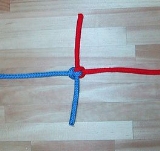
Zeppelin bend
Encyclopedia
A Zeppelin bend is a general purpose bend knot. It is a secure, easily tied, and jam-resistant way to connect two ropes. Though its simplicity and security may be matched by other bends, it is unique in the ease with which it is untied, even after heavy loading.
airship
s: a Zeppelin
being a rigid-bodied type of airship, and Charles Rosendahl being the US Navy officer who allegedly insisted it be used to moor airships under his command.
In fact, actual research shows that Rosendahl seeming had no knowledge of this knot, and its use (or the use of any bend) is hard to conceive --esp. as critical. Nevertheless, the names have been used and are in the public mind, now.
Despite being praised by some sources as a nearly ideal bend knot, it is not very well known; Clifford Ashley
, author of The Ashley Book of Knots
, was apparently unaware of this bend.

Another method of remembering this knot is to visualize a "69". To tie the knot, follow the steps below.
History
Both names for this knot stem from its alleged (but now regarded as mythical!) use to moorMooring mast
A mooring mast, or mooring tower, is a structure designed to allow for the docking of an airship outside of an airship hangar or similar structure...
airship
Airship
An airship or dirigible is a type of aerostat or "lighter-than-air aircraft" that can be steered and propelled through the air using rudders and propellers or other thrust mechanisms...
s: a Zeppelin
Zeppelin
A Zeppelin is a type of rigid airship pioneered by the German Count Ferdinand von Zeppelin in the early 20th century. It was based on designs he had outlined in 1874 and detailed in 1893. His plans were reviewed by committee in 1894 and patented in the United States on 14 March 1899...
being a rigid-bodied type of airship, and Charles Rosendahl being the US Navy officer who allegedly insisted it be used to moor airships under his command.
In fact, actual research shows that Rosendahl seeming had no knowledge of this knot, and its use (or the use of any bend) is hard to conceive --esp. as critical. Nevertheless, the names have been used and are in the public mind, now.
Despite being praised by some sources as a nearly ideal bend knot, it is not very well known; Clifford Ashley
Clifford Ashley
Clifford Warren Ashley was an American artist, author, sailor, and knot expert. He was born in New Bedford, Massachusetts, son of Abiel Davis Ashley and Caroline Morse. Ashley married Sarah Scudder Clark in 1932 and had two daughters, also adopting his wife's oldest daughter from a previous...
, author of The Ashley Book of Knots
The Ashley Book of Knots
The Ashley Book of Knots is an encyclopedia of knots first published in 1944 by Clifford Warren Ashley. The culmination of over 11 years of work, it contains some 7000 illustrations and more than 3854 entries covering over 2000 different knots. The entries include instructions, uses, and for some...
, was apparently unaware of this bend.
Tying

- Form a loop in each of the ends of rope
- Overlay one loop on the other, such that the working end of each rope faces "outwards" or away from the other hitch
- Pull either loose end once around the loop in the other rope, and then through the "tunnel" created by the two hitches
- Repeat with the other loose end
- Pull on all four rope parts to tighten the knot.
- To untie, pull simultaneously on the two turns that go round the standing parts.
Another method of remembering this knot is to visualize a "69". To tie the knot, follow the steps below.
- Make a "6" with the line (rope) in your left hand. It is important that the bitter end winds up on top of the standing end for the "6".
- Make a "9" with the line in your right hand. Make sure that the standing end crosses over the bitter end of the "9".
- While keeping both "numbers" intact, place the "6" over the "9", with the circle parts of each number lining up.
- Take the "tail" of the "6" and put it through the middle (circle) part of your "69".
- Take the "tail" part of the "9" and bring it up through the middle (circle) part of your "69".
- Pull each standing end while ensuring that the bitter ends are not pulled from the "69" holes.

